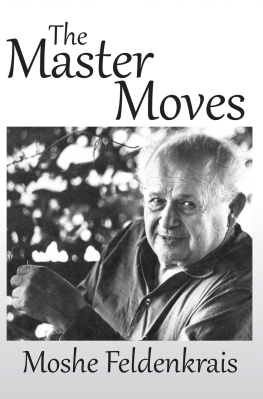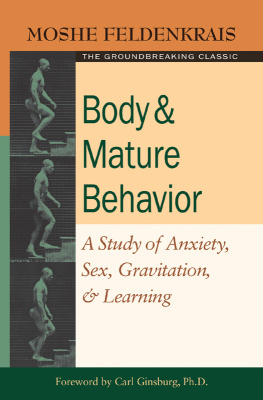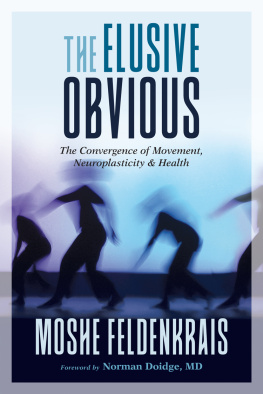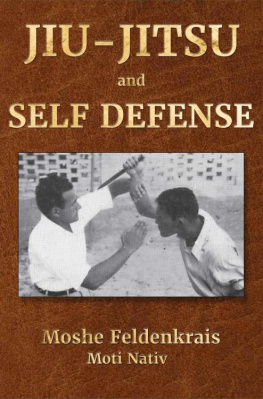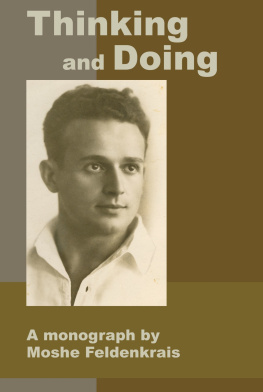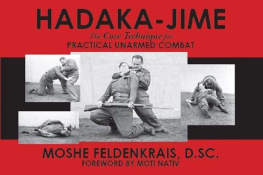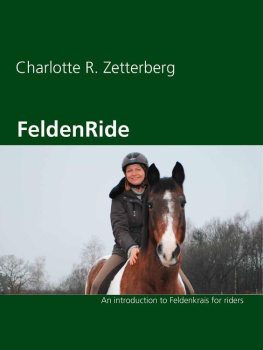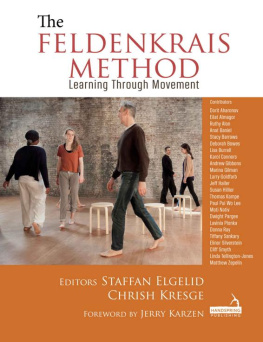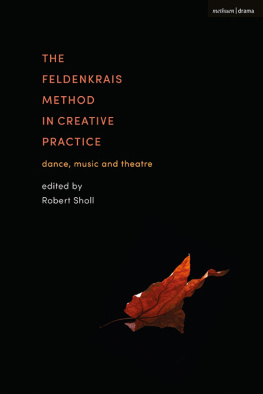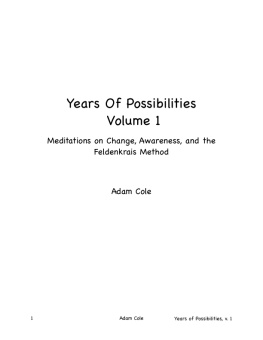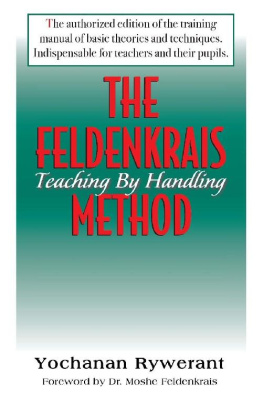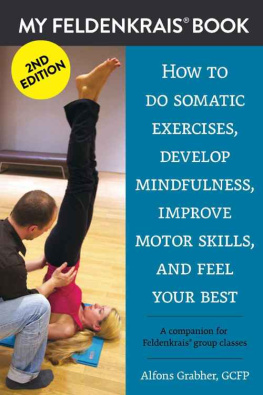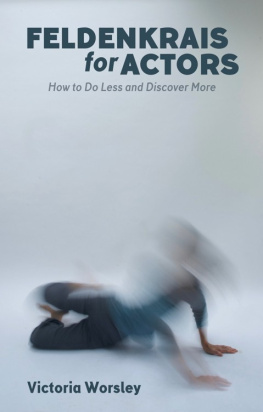MEDICAL DISCLAIMER: The following information is intended for general information purposes only. Individuals should always see their health care provider before administering any suggestions made in this book. Any application of the material set forth in the following pages is at the readers discretion and is his or her sole responsibility.
TRIBUTE TO THE FELDENKRAIS ESTATE
The International Feldenkrais Federation would like to acknowledge the generosity of the Feldenkrais family in making this work available for publication. Their willingness to share Dr. Feldenkrais materials allows ongoing development and publication of valuable resources for those who continue his work. In keeping with Moshes love for and early adoption of new technology, we are pleased to publish this new edition in both print and electronic formats.
The Board of the IFF Distribution Center
ACKNOWLEDGMENTS
Carl Ginsburg for his editing and for keeping the sound of Moshe in the manuscript.
Edna Rossenas (formerly Enda Sott) for transcribing the original workshop tapes.
Anat Baniel and Mark Reese for their editorial assistance.
Bonnie Freer, photographer, for all the photographs of Moshe in this book.
Kolman Korentayer for his advice and editorial assistance on the photographs, text, and style of this book.
Richard Bandler
Publisher, 1st edition
* * *
Thank you to the following people for helping to bring the 2nd edition of The Master Moves to life.
Faisal Alisdairi, Marcela Bretschneider, Jenni Evans, Allegra Heidelinde, Josh Lake, Shalom Mayberg, Kai Schaper, Maggie Tomberlin, Janice Vincent, and Tamar Wyte.
THE META INTRODUCTION
I am looking at the picture of Moshe and I walking down the path to the swimming pool at the Mann Ranch and remembering the many paths we traveled together, the times we shared, and our beginnings.
I really loved and cared for him in a special way. He once said that time and love are interchangeable: those you love, you have time for. My availability for Moshe was timeless. You may ask, what qualities would earn this kind of caring and devotion?
When I first met Moshe it was at his office in Tel Aviv, a very modest place - one assistant, his first, Mia Segal; two worktables; a few stools to sit on; a small desk, and his special joy - paintings by his mother adorning the walls.
He invited me to sit in his office and watch him work with his clients. He called them students because they were learning a new way of functioning. During this visit of two months, I observed him working with over 100 people, many of whom had serious movement difficulties, such as strokes, cerebral palsy, etc. In every case their situation improved during the time that Moshe worked with them.
While in Tel Aviv I had the opportunity to have a series of lessons with Moshe myself. The impact of these lessons was profound: I moved differently; I felt better; my thinking became richer and clearer. I decided then and there to make myself available to Moshe for the purpose of assisting him in getting his work out into the world.
I went back to the U.S. and organized the first of an annual series of lectures, workshops, and teaching programs - and thus began the Moshe-Kolman Road Show.
It was a great adventure traveling with him, watching him grow and change, and observing the effect he was having on people. During the workshops many participants would come up to tell him of the miraculous changes that happened to them during the Awareness Through Movement lessons.
Our travels took us from Coast to Coast, to such places as Esalen Institute in Big Sur to the U.S. Congress in Washington; to meetings and friendships with such people as Margaret Mead, Karl Pribram, Heiz M. Von Foerster, Jonas Salk, Milton Erickson, and Gregory Bateson, plus the many thousands who attended his workshops, and over 400 who are now practitioners of his work.
On our travels one of the places we looked forward to most was the Mann Ranch, presided over by Larry Thomas. After those large lectures with hundreds of people, the intimacy of the ranch enabled Moshe to share his work with ease and joy. There were usually twenty-five participants in the program, and since we all lived in the big house together, Moshe got to know everyone personally. Out of these five-day sessions with their special warmth and character, emerged a unique workshop which Moshe felt presented the essentials of his work.
The book you are about to experience is this workshop.
Welcome to the masterful and moving world of Moshe Feldenkrais.
This and more are my memories.
Thank you Moshe.
Kolman Korentayer
INTRODUCTION
Carl Ginsburg
I attended my first Feldenkrais workshop during the summer of 1974. It was taught by a man who spent only a month with Moshe Feldenkrais and was not a qualified teacher of the Feldenkrais Method. Nevertheless he had absorbed enough of the Feldenkrais spirit to convey something of the essence of Moshes work.
I was at that time suffering from periodic bouts of low back pain and exploring various body therapies to alleviate my trouble. But I was initially reluctant to try Feldenkrais work. Feldenkrais movement, I had heard, had something to do with coordination. I knew I had poor coordination and I thought of myself as clumsy, without grace, a poor athlete and a terrible dancer.
The workshop was a revelation. In two days I discovered that I had all the ability to change what I wanted changed. It was possible for me to dance and move freely. I could stand in gravity and my pelvis could be underneath my shoulders. Above all I could do simple movements that would allow me to lengthen shortened muscles as long as I moved with what Feldenkrais called awareness.
As I no longer suffered with disabling muscle spasms in my back, I spent the next months talking of nothing but Feldenkrais work. During the winter, I heard that Feldenkrais himself was organizing a professional training group in San Francisco the following summer. I immediately applied; I was sure Moshe had answers for much of what I wished to understand.
Moshe arrived the first day of the training with essentially the same baggy trousers, the same open shirt we would see for the next three summers of training. His round pixie-like face combined with the two shocks of white hair on either side of his bald head gave him the air of a gentle but authoritative father. He walked slowly to protect his injured knees, the problem that led to his discoveries, but he was solid and balanced. As he sat facing the class in the center of the room we were suddenly under his spell.
Moshe always sat in the center facing his students. It produced a situation of authority whereby Moshe dominated what happened in the group. But it was an authority to create a context for learning. For his intent was always to provoke people to experience themselves directly and to make judgments and discernments out of that experience. When he challenged, it was on the basis that the person challenged had not used his or her own capacity to think and find out what is correct through experience and exploration. His authority was never authoritarian.

